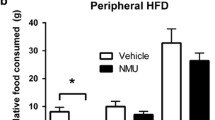Abstract
The current study demonstrates the ability of neuropeptide Y (NPY) to increase break points under a progressive ratio 1 (PR1) reinforcement schedule. An initial response resulted in delivery of a food reinforcer (45 mg pellet) under the PR1, and an additional response was required foreach successive reinforcer. The break point, the number of responses emitted to obtain the last reinforcer, is considered a measure of reinforcing efficacy or motivational strength of the food reinforcer. NPY (0.3–10 µg) significantly increased break point to levels comparable to those produced by 36–48 h of food deprivation. Although insulin (3–8 U/kg) and 2-deoxyglucose (150–250 mg/kg) also increased food intake, neither increased break points to levels produced by NPY or food deprivation. These data suggest that NPY may change the value of food in ways that cannot be accounted for by changes in insulin, glucose levels or intracellular glucoprivation. These results emphasize that simply measuring the amount of freely available food eaten is not a fully adequate measure of the strength of the feeding behavior.
Similar content being viewed by others
References
Abe M, Saito M, Shimazu T (1989) Neuropeptide Y and norepinephrine injected into the paraventricular nucleus of the hypothalamus activate endocrine pancreas. Biomed Res 10:431–436
Allen YS, Adrain TE, Allen JM, Tatemoto K, Crow TJ, Bloom SR, Polak JM (1983) Neuropeptide Y distribution in rat brain. Science 221:877–879
Anand BK, Brobeck JR (1951) Hypothalamic control of food intake in rats and cats. Yale J Biol Med 24:123–14
Billington CJ, Briggs J, Grace M, Levine AS (1991) Effects of intracerebroventricular injection of neuropeptide Y on energy metabolism. Am J Physiol 260:R321-R327
Boublik J, Scott NA, Brown MR, Rivier JE (1989) Synthesis and hypertensive activity of neuropeptide-Y fragments and analogs with modified N-termini or C-termini or D-substitutions. J Med Chem 32:597–601
Clark JT, Kalra PS, Crowley WR, Kalra SP (1984) Neuropeptide Y and human pancreatic polypeptide stimulate feeding behavior in rats. Endocrinology 115:427–429
Clark JT, Kalra PS, Kalra SP (1985) Neuropeptide Y stimulates feeding but inhibits sexual behavior in male rats. Endocrinology 117:2435–2442
Flood JF, Morley JE (1991) Increased food intake by neuropeptide Y is due to an increased motivation to eat. Peptides 12:1329–1332
Flood JF, Hernandez EN, Morley JE (1987) Modulation of memory processing by neuropeptide Y. Brain Res 421:280–290
Griffiths RR, Bradford LD, Brady JV (1979) Progressive ratio and fixed ratio schedules of cocaine-maintained responding in baboons. Psychopharmacology 65:125–136
Hodos W (1961) Progressive ratio as a measure of reward strength. Science 134:943–944
Hodos W, Kalman G (1963) Effects of increment size and reinforcer volume on progressive ratio performance. J Exp Anal Behav 6:387–392
Jewett DC, Cleary J, Levine AS, Schaal DW, Thompson T (1992) Effects of neuropeptide Y on food-reinforced behavior in satiated rats. Pharmacol Biochem Behav 42:207–212
Levine AS, Morley JE (1984) Neuropeptide Y: a potent inducer of consummatory behavior in rats. Peptides 5:1025–1029
McDonald JK (1988) NPY and related substances. Crit Rev Neurobiol 4:97–135
Miselis RR, Epstein AN (1975) Feeding induced by intracere-broventricular 2-deoxy-d-glucose in the rat. Am J Physiol 229:1438–1447
Moltz JH, McDonald JK (1985) Neuropeptide Y: direct and indirect action on insulin secretion in the rat. Peptides 6:1155–1159
Ritter S (1986) Glucoprication and the glucoprivic control of food intake. In: Ritter RC, Ritter S, Barnes CD (eds) Feeding behavior: neural and humoral controls. Academic Press, Orlando, pp 271–313
Stanley BG, Leibowitz SF (1985) Neuropeptide Y injected into the paraventricular hypothalamus: a powerful stimulant of feeding behavior. Proc Natl Acad Sci USA 82:3940–3943
Tatemoto K, Carlquist M, Mutt V (1982) Neuropeptide Y: a novel brain peptide with structural similarities to peptide YY and pancreatic polypeptide. Nature 296:659–662
Teitelbaum P (1957) Random and food-directed activity in hyperphagic and normal rats. J Comp Physiol Psychol 48:156–163
Tryon WW (1982) A simplified time-series analysis for evaluating treatment interventions. J Appl Behav Anal 15:423–429
Author information
Authors and Affiliations
Rights and permissions
About this article
Cite this article
Jewett, D.C., Cleary, J., Levine, A.S. et al. Effects of neuropeptide Y, insulin, 2-deoxyglucose, and food deprivation on food-motivated behavior. Psychopharmacology 120, 267–271 (1995). https://doi.org/10.1007/BF02311173
Received:
Revised:
Issue Date:
DOI: https://doi.org/10.1007/BF02311173




